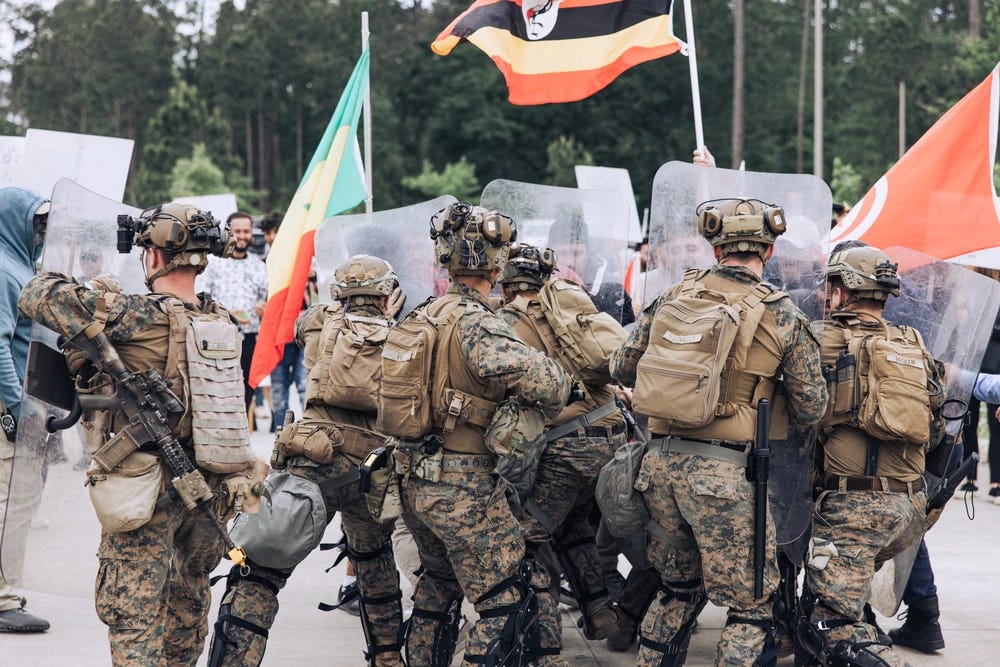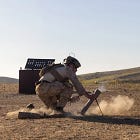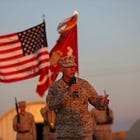Redefining MEU Workups: Training for the Probable, Not Just the Possible
Captain Mitchell Teefey
This article examines shortcomings in the current MEU pre-deployment training program. Part 1 analyzes the existing structure and highlights missed training opportunities. Part 2 offers recommendations for how platoons and companies can overcome limited resources to achieve mission readiness.
Part I
The MEU Workup: Structure, Philosophy, and the Limits of Focus
The pre-deployment work-up for a Marine Expeditionary Unit (MEU) is a difficult but remarkably consistent process. No matter where you’re stationed or what geopolitical curveballs are in the air, the sequence remains generally the same: helo-borne raids, ship-to-shore breaches, and a culminating MEUEX where a reinforced company simulates the seizure of a fictional airfield, usually defended by notional Cold War-era adversaries. It’s a ritual built on repetition and reinforced by a shared belief across the Fleet Marine Force: that an amphibious raid is the most complex thing we do, and therefore, it’s the thing we should train for the most.
This isn’t a misguided assumption. There’s a certain logic to anchoring your pre-deployment training in the most demanding scenario possible. Amphibious raids require a blend of naval integration, aviation synchronization, logistical reach, and layered command and control. The idea is that if Marines can execute this with competence and confidence, they can handle anything else the operational spectrum throws their way. In this way, the MEU workup doesn’t just build capability, it builds institutional reassurance. It says, “We’ve trained for the hardest fight; we’re ready for the rest.”
But this model has a flaw.
It presumes that all other missions are just easier versions of the same thing. That you can scale down from a complex, kinetic amphibious raid to something like a non-combatant evacuation operation (NEO) without losing effectiveness. The problem is, real-world operations rarely cooperate with that logic. They tend to be less clean, more fluid, and often built around incomplete information and ambiguous environments. And while the Command Element and the Aviation Combat Element (ACE) spend the latter half of the workup refining those larger operational puzzles, the Battalion Landing Team (BLT) and the Marines who will actually execute those small, human-scale missions, often experience a slow atrophy of tactical sharpness. The rifle squads that finish the Marine Corps Combat Readiness Evaluation strong begin to bleed readiness as the training pipeline shifts focus to command post exercises and large-scale planning drills. It's not sabotage; it’s just bandwidth. And the bandwidth goes where the institutional spotlight shines.
That doesn't mean readiness is doomed to fade, it just means sustaining it requires intention. Platoon commanders and squad leaders who recognize this gap can take initiative in the white space between large-scale events. Whether it’s practicing urban combat drills, running logistics-lite patrol base scenarios on a company LZ, or just drilling the basics with a more specific purpose, small unit initiative remains the most agile lever for retaining readiness amid the MEU’s broader structural priorities.
Still, it's worth acknowledging that amphibious raids, while the philosophical center of gravity for the MEU workup, is not the most frequent mission these units are called to perform. And it’s not even close. The operations MEUs conduct most often exist in a different category altogether. Less kinetic, more improvisational, and often triggered by events that don’t follow a clear enemy template. These are known as limited contingency operations (LCOs), and they operate by an entirely different logic.
Limited Contingency Operations: The Real Work of the MEU
There’s a category of missions in the Marine Corps that doesn’t get much airtime outside of doctrine and school house briefs. Officially, they’re called “limited contingency operations,” or LCOs. It’s a term that feels like it was built for a staff slide; neatly bureaucratic, intentionally vague, and easy to skim past. But LCOs are anything but obscure in practice. They are the missions MEUs get called to perform again and again: urgent, unscripted situations that exist somewhere between crisis response and conventional operations. These aren’t wargame hypotheticals, they’re real-world events that happen with relative frequency. Evacuate an embassy before nightfall. Deliver relief supplies into a disaster zone that no one else can reach. Insert a force to recover isolated personnel before the story breaks open-source. More often than not, this is what MEUs actually do. (1)
And when they do it, they’re walking into uncertainty. LCOs often don’t follow clean lines or easily templated patterns. Marines are asked to operate under diplomatic pressure, with rules of engagement (ROE) that might not be finalized, in environments where civilians panic, interpreters are scarce, and floor plans are sent as grainy PDFs. In these operations, you're not scaling down from a high-end kinetic raid. You're working laterally, in a new category altogether. In a LCO logistics can be the main effort, speed can matter more than mass, and mission success criteria might change mid-flight.
The dissonance is clear when you look at the historical record, not the greatest hits, but the full catalog. It’s easy to assume that Marine Corps history is defined by epic set-piece amphibious battles: Tarawa, Peleliu, Inchon. They’re the kinds of events that get memorialized on command boards and tattooed across unit pride. But if you spend any time digging through the archives, what starts to emerge is a quieter but no less significant thread; LCOs that required flexibility, speed, and judgment more than brute attritional combat power. Evacuations under fire. Embassy reinforcements in collapsing states. Humanitarian operations where the mission was to bring water, not take ground.
In 1991, Marines from the 13th MEU executed Operation EASTERN EXIT during the collapse of the Somali government, flying two CH-53Es over 450 miles at night to extract 281 people from Mogadishu. It was a mission pulled off under pressure, barely rehearsed, and almost entirely outside the scope of the traditional MEU syllabus. But it worked, and it became a blueprint for NEOs that’s still studied at Expeditionary Warfare School today. Five years later, the 22nd MEU repeated that model during Operation ASSURED RESPONSE in Liberia, inserting under small arms fire to secure a U.S. embassy and evacuate more than 2,100 people. These weren’t one-off exceptions, they were signals of what the future would hold.
And yet, the way we train hasn’t kept pace. MARADMIN 221/25 puts NEOs near the top of the priority list, calling for a mission essential task review. But in the day-to-day execution of the MEU workup, these types of missions are still treated as secondary. They’re wedged in white space between raid packages and amphibious rehearsals. The scoreboard tells one story. The training calendar still tells another.
Which leads to a question the institution must keep asking itself: if the most frequent missions we conduct are LCOs, why are we still building our entire training arc around scenarios that are extremely rare?
Rethinking the Culmination: NEO as a Realistic, Rigorous Alternative
If we take the Marine Corps’ training philosophy at face value, train for the hardest thing so that everything else becomes more manageable, then the amphibious raid makes sense. It’s complex and demanding at every level, from planning to execution to extraction. It forces integration, coordination, and disciplined action under pressure. That’s why it served as the centerpiece of the MEU workup for so long. But the premise shouldn’t be sacred, the principle behind it is what actually matters. And that principle can still hold, even if the culminating scenario changes.
Because what if the “hardest thing” isn’t always a contested beach landing? What if it’s something far more likely and just as demanding? A NEO in a semi-permissive littoral, for example, isn’t easier, it’s just as difficult in a different dimension. Imagine a culminating event where the BLT secures an embassy perimeter under sporadic enemy fire. The Logistics Combat Element establishes relief-supply distribution points while maintaining convoy security through an uncertain urban sprawl. The ACE executes tiltrotor insertions and extractions in a fragmented airspace with evacuees aboard. Meanwhile, the Navy ships take on a dual role: floating command centers and triage hubs for displaced civilians. Add in joint and interagency partners with overlapping mandates and a shared sense of urgency, and the problem starts to resemble the kind of complex, uncertain environment that Marines routinely find themselves in. Not in theory, but in actual deployments.
These are not just “scaled-down” versions of high-intensity conflict. LCOs, especially NEOs and humanitarian and disaster relief (HADR) missions, introduce a level of ambiguity and chaos that can’t be approached with the same tactical muscle memory used for conventional assaults. They require deliberate training in consent and non-consent evac flows. They demand embassy layout rehearsals, cultural awareness, and improvisational logistics planning for infrastructure that might not exist. Communication links are unreliable, ROEs are often vague, and intelligence is usually incomplete or already outdated by the time wheels are up.
It’s not a softer skill set. It’s just a different one built around decision-making in the gray, not the black and white. And that skill set is perishable. The current model offers only a few chances to rehearse these missions before deployment, often tucked into a planning cell or added as an afterthought. But if we gave these scenarios the full weight of a culminating event and elevated them to the same level of seriousness we reserved for amphibious raids, we’d align our training with our most likely tasking. Most importantly, we’d be preparing Marines for a kind of complexity that’s hard to simulate.
A NEO conducted at MEU scale, with full Blue-Green integration, doesn’t just meet the threshold of “hard.” It redefines it. It forces distributed planning, logistical agility, and ethical clarity in a time-sensitive environment. It challenges the command element, the aviation planners, the infantry squads, and the sustainment Marines all at once. And critically, it prepares them for the missions they are statistically most likely to execute.
Reframing the culminating event in this way doesn’t reject institutional philosophy, it sharpens it. It takes the logic of “train for the hardest fight” and recalibrates it toward a more relevant threat model. In doing so, it gives Marines a chance to master the missions they’re actually getting called to perform with the same seriousness, rigor, and repetition we’ve always brought to the beach.
Part II: No One’s Coming to Save You—Training Your Platoon for LCOs
As a platoon commander, you’re usually handed a training window between when the MEU composites and you’re first MAGTF exercise. Let’s say, the three weeks between range qualifications and MEUEX; where the institutional spotlight is pointed elsewhere. That “white space” can feel like idle time, but it’s actually a blank slate. Your Marines need meaningful repetition, not just another PowerPoint brief or a checkbox exercise. What they need is focused, scenario-based training that mirrors the LCOs they’ll likely face.
So, consider this your playbook. In the sections that follow, we’ll map out how to design and execute platoon-level LCO drills using existing resources and timelines. You won’t need to call in a full staff cell or steal valuable higher headquarters bandwidth. You’ll leverage what you have: personnel, terrain, and time. The training you’ll create will build competence and confidence in evacuations, embassy layouts, casualty handling, and rapid logistics. In short, you’ll turn the MEU’s quiet gaps into the most valuable training you can give your Marines
Know the Game: You’re a Crisis Responder First
Start by reframing the mission for your Marines. LCOs aren’t “secondary” or “supporting” tasks. They’re the main event nine times out of ten.
You’re not just a platoon commander. You’re the guy who might have to stabilize an embassy under protest. You’re the one who might need to evac 200 civilians while figuring out how to do crowd control with a translator and a megaphone that doesn’t work. That’s not a soft skill, that’s a warfighting skill.
Once your Marines see it that way, everything else gets easier.
The White Space Is Yours: Guard It Like It’s an HLZ Full of Civilians
Let’s get real. The pre-deployment calendar is chaos. But there are gaps. And those gaps? That’s where you win.
Here’s your play: treat white space like opportunity, not dead time. Block off 2-3 day windows and run your own mini-scenarios.
Mock Embassy Reinforcement: Use any building on base. Assign Marines to play embassy staff. Make it messy: Introduce crowd control issues, simulate fire or comms loss, throw in a “hostile actor” or angry local police. Let your squad leaders practice perimeter control, civilian management, and escalation of force without live fire.
Tabletop NEO Drills: Set up your platoon like a TTP walkthrough. Give your squad leaders a floor plan and a warning order. Work through evac flow, link-up with consular reps, HLZ security, and evac control procedures. Make it time-constrained. Give bonus points for calm voice inflection under pressure. If you yell and scream, the crowd will match and mirror you.
HADR Simulation: This one’s gold and never gets done. Give your platoon an engineer problem: collapsed bridge, flooded zone, and a water purification requirement. Have them move gear, create routes, or organize supply distribution with the gear they actually have in their pack. No notional BS. If they can’t do it with what’s in the 7-ton, they need to fix the load plan.
Tight on time? Do one-hour injects during chow. Call it a “CRISIS 15.” Someone walks in and says, “Embassy in Country X just took indirect fire. Civilians are gathering at the gate. Go.” Then see who can think fast and lead under stress.
Add the Soft Chaos: Civilians, Communication, and Coordination
LCOs don’t typically go sideways because someone forgot to stack right on a door. They go sideways because nobody knows who’s in charge of the evac line, nobody brought a translator, and everyone assumed the generator was magically going to fuel itself.
So train for that kind of friction:
- Assign Marines to be evacuees; one speaks no English, one refuses to leave without their family, one is “injured.”
- Have your team build a non-combatant evac manifest from scratch. Make them prioritize. Who goes first? Who gets security? Who needs medical care?
- Run a comms denial scenario—force your team to coordinate without VHF. Give them radios that “don’t work” and force hand-written messages or runner systems.
These are the kind of details that separate “we made it through” from “we controlled the chaos.”
Make It Competitive: Marines Hate Losing More Than They Love Winning
Gamify it. Turn your white-space LCO drills into team-based events. Who can evac 20 civilians with the least chaos? Who can secure a compound with the fewest “casualties”? Who can create a disaster logistics node fastest using real tents, real water cans, and the actual number of Marines they’d have in sector?
Teach the Why: Without Sounding Like a TED Talk
If you want buy-in, you need to explain the “why.” Not in a classroom, but in a warrior night-style moment. Pull your squad leaders aside and lay it out:
“This isn’t extra credit. This is what you’re actually going to do. Some day in the next year, a call’s going to come in. There’s going to be a U.S. embassy under threat, or a village flattened by an earthquake, or a government collapsing in real-time. And you—you—are going to be the one the Combatant Commander calls. Not Delta. Not DEVGRU. You. And you’ll be doing it in PVS-14s.”
When you frame it like that, NEO isn’t a distraction. It’s the Super Bowl.
Bottom Line: Own Your Platoon’s Readiness
You can’t redesign the MEU workup in a single plan, nor should you expect to. But you can reshape your platoon’s readiness in those gaps where the institution’s focus drifts elsewhere. In that window, ensure your squad leaders can secure an embassy stairwell, manage a crowd of distressed civilians, or sustain a 24‑hour relief point with limited resources and no external support.
LCOs aren’t about scripted assaults or polished CONOPs, they’re about applying training in controlled chaos. Your Marines need to become comfortable operating with incomplete information, shifting priorities, and improvised solutions. The tools you’ll use like floor‑plan walkthroughs, crowd‑control drills, casualty‑evac scenarios, require nothing more than a plan, some creativity, and the determination to repeat until it becomes muscle memory. No special waiver. No extra funding. Just the willingness to treat that “white space” as your most valuable asset.
No one’s coming to save you. But you can damn sure train like you’re the ones who are going to save everyone else.
Captain Mitchell Teefey is an active-duty Infantry Officer. He currently serves as Operations Officer for Recruiting Station Sacramento. Previously, he served as a Rifle Platoon Commander with 1st Battalion, 8th Marines during Operation ALLIES REFUGE. He can be reached at Mitchell.Teefey@marines.usmc.mil
(1) Marine forces, including MEUs, have executed numerous NEOs since 1975. These include South Vietnam (1975), Cambodia (1975), Lebanon (1976), Lebanon (1982), Grenada (1983), Liberia (1990), Somalia (1991), Rwanda (1994), Central African Republic (1996), Albania (1997), Sierra Leone (1997), Zaire (1997), Eritrea, (1998), Liberia (2003), Lebanon (2006), Japan (2011), South Sudan (2014), Yemen (2015), Afghanistan (2021), and Haiti (2024). Compare this to zero contested amphibious raids. See Annette D. Amerman, The Marines Have Landed: Eighty Years of Marine Corps Landings, 1935-2015, Marine Corps History Division, 2016, https://www.govinfo.gov/content/pkg/GOVPUB-D214-PURL-gpo83508/pdf/GOVPUB-D214-PURL-gpo83508.pdf.











Very well written analysis and practical recommendations for the platoon et al. Some notes; the author is spot on about the prevalence of LCOs as a 'most probable' mission set. Working the immediately optimal solution at the platoon level is both the most pragmatic and plausible solution. From the HKIA AARs and Interviews, the immediate strain from emerging problems was occurring at the platoon and squad level, underlying where the first training solution lies. The baby bird syndrome for training is always a potential issue (the small units tendency towards crying "train me, train me" and never growing feathers and talons to train themselves). As Capt. Teefey says, "The White Space Is Yours: Guard It Like It’s an HLZ Full of Civilians". Seizing training gaps to find your third(s) of the training time is art, science, and essential. In continuous combat and other operations, small unit leaders are still going to have to manage training as a continuing action. Capt. Teefey's rec's are well made and well taken.
Awesome. This is some of the very best expectation-setting and advice for platoons preparing for MEUs (at least our current construct) that I've seen. Very, very well done. This is the advice/guidance I wish I'd written!
One thought on using NEOs as hard test cases: In training the ARG/MEU, we need to think MUCH bigger. As in, international airport-sized objectives and thousands of (simulated) evacuees, not some single building designated as the "embassy" with a few dozen role players. (On CPEN, that might equate to securing the whole Sierra TA / Tomato Patch.) To really drive proficiency and SOP development, our scenarios should require all of the following: manned and unmanned area and route reconnaissance, DATF, SEAD, long-range insert via intermediate staging base and intra-Theater lift (let's see if anyone's ready to prepare TPFDD and execute ULN swaps), all manner of information operations, and of course an uncertain operating environment pressurizing security, intelligence operations, logistics/medical, and evacuation processing. Something like this doesn't replace a mere raid on the sequence of training events; it replaces one of the amphibious assaults. And it will provide better training / force better preparation across the ARG/MEU for the type of employment we all think to be both the most difficult and most likely.